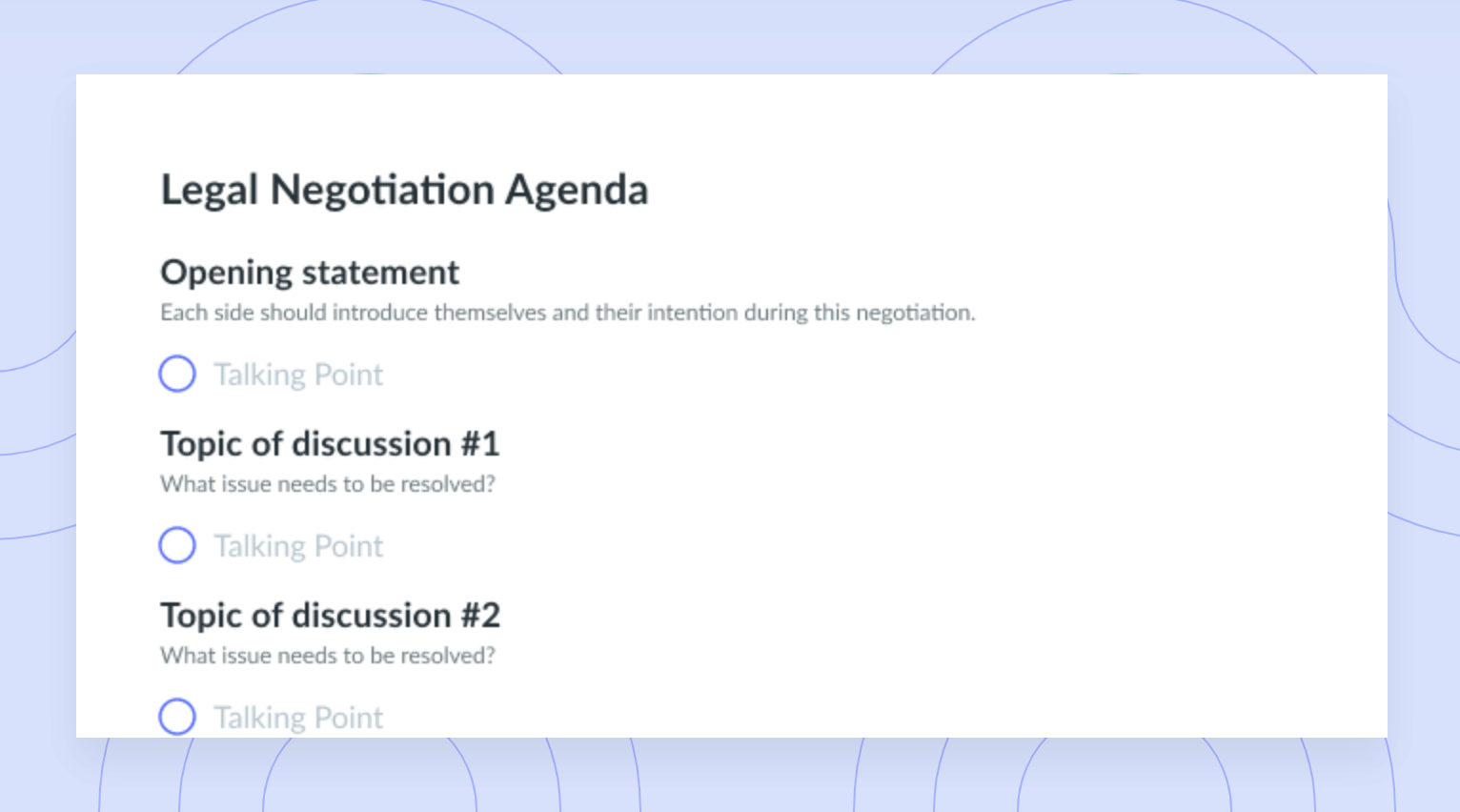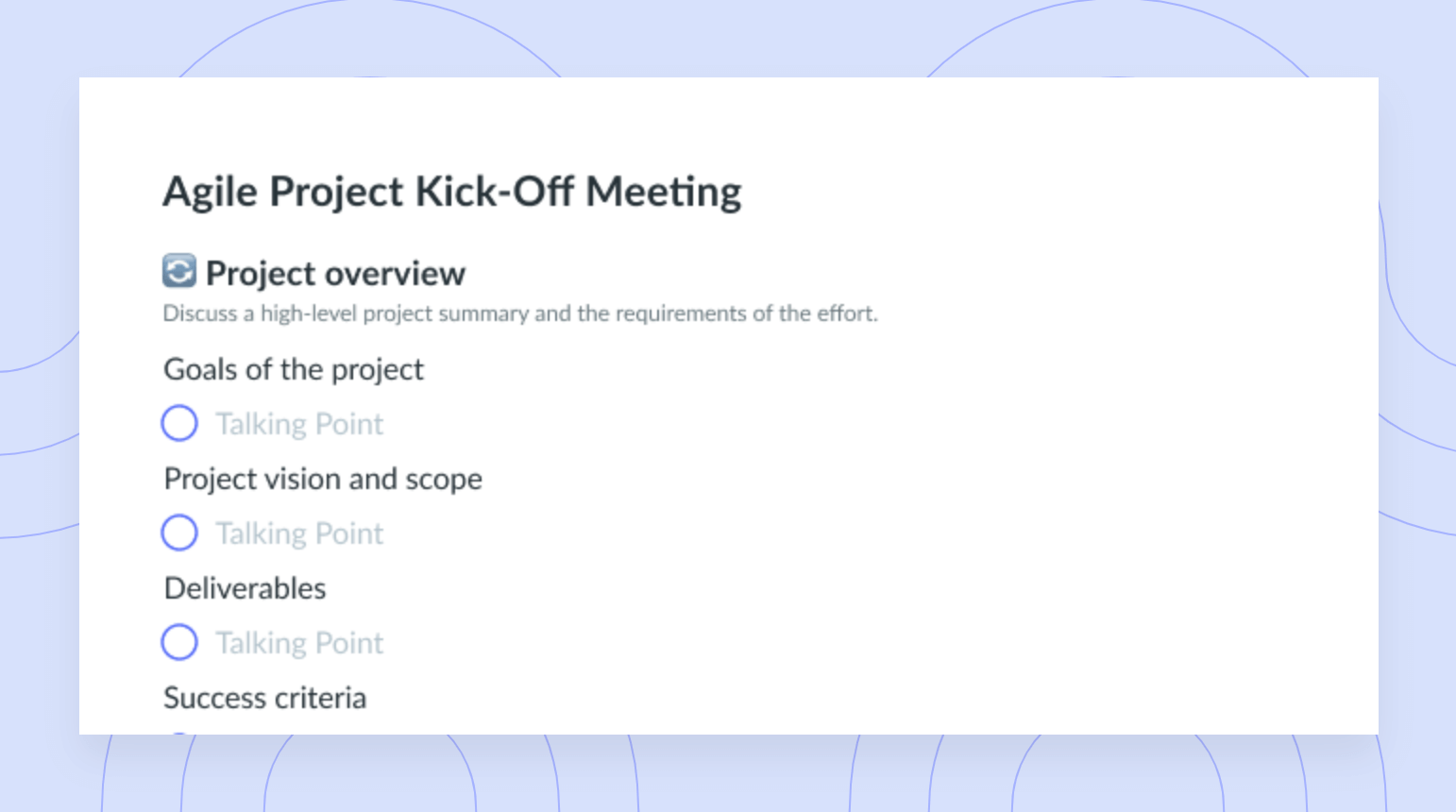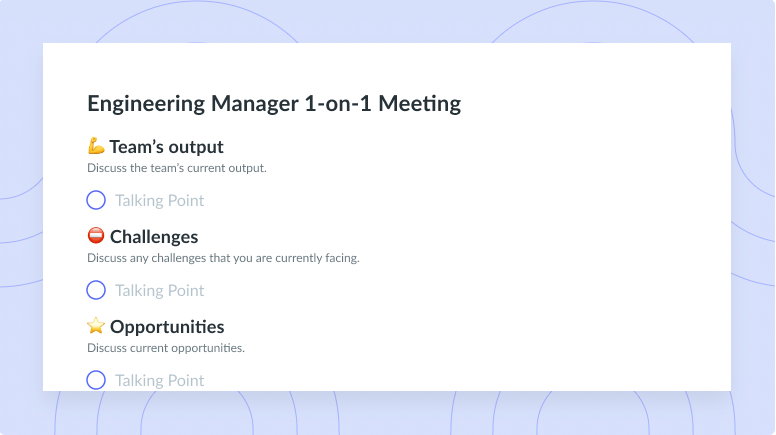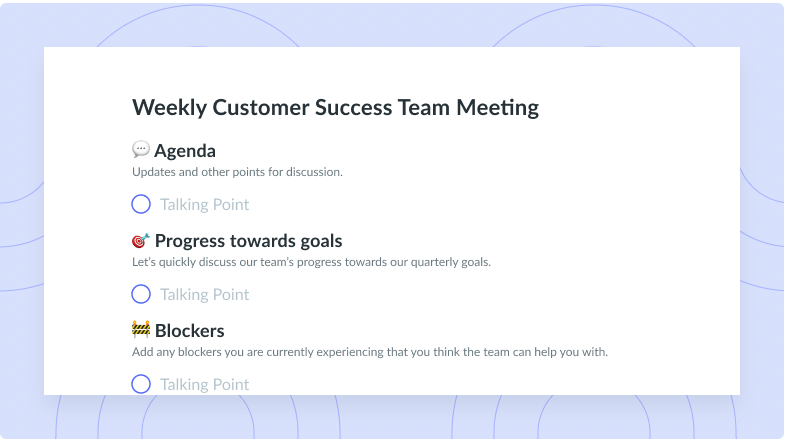Increase Meeting Productivity: 11 Tips
Learn how to increase meeting productivity to improve decision-making and reduce burnout with these 11 tips!
Hosting productive meetings can be tricky, which is why it’s important to use all the tools at your disposal. In this article, we’ll cover 11 in-depth tips for running more productive meetings so you can engage your team, foster alignment, and increase meeting productivity.
- How meetings affect your team’s productivity
- 11 tips for running more productive meetings
- Increase meeting productivity with Fellow
How meetings affect your team’s productivity
Meetings can have a significant impact on your team’s productivity, both positively and negatively. If you fail to host effective meetings, you may notice several negative effects such as poor decision making; lost time, money, and resources; reduced focus; decision paralysis; fatigue; meeting overload; and burnout.
11 tips for running more productive meetings
- Use a collaborative meeting agenda
- Use a meeting management software
- Track how long your meetings are
- Assign meeting action items
- Only invite those who provide value to the meetings
- Collect meeting feedback
- Send a meeting follow-up email
- Shorten your meetings
- Host asynchronous meetings
- Have a meeting-free day
- Assign meeting roles
1Use a collaborative meeting agenda
Building a collaborative meeting agenda can be a game changer for your productivity, and tools like Fellow make it easier than ever to create thorough, collaborative agendas—especially when you can find everything you need to host an intentional meeting in one place. With Fellow, you can build collaborative meeting agendas, record decisions, and keep your teammates accountable before, during, and after every meeting.

Run productive meetings, come to a decision, and get back to work
Level up your meeting habits to boost engagement and productivity with a collaborative meeting agenda. Try a tool like Fellow!

2Use a meeting management software
Fellow is an all-encompassing meeting management platform that helps users drive engagement and productivity by building better meeting habits before, during, and after every meeting. As your one-stop shop for meeting agendas, action items, and feedback, Fellow makes it possible to build better meeting habits and run more effective meetings with collaborative meeting agendas, real-time note-taking, and time-saving templates. With Fellow you can keep track of work interactions and feedback over time, collaborate on meeting agendas, assign clear action items at the end of each meeting, and centralize information, making it easier than ever to increase meeting productivity.
Pro tip: Shape your team’s meeting habits with built-in Meeting Guidelines that enable thoughtful creation, boost meeting engagement, and make room for deep work and execution.
3Track how long your meetings are
A meeting timer is an excellent resource that can be leveraged to increase meeting productivity. A great meeting timer will help you monitor time spent vs. time planned for the overall meeting and each segment of the meeting, meaning you can keep meetings on track, track time-based tasks, and stick to your meeting agenda. Meeting timers can also be used to limit the amount of time each member speaks in case one person is talking too much or certain attendees haven’t had the chance to add to the conversation.
Unlike other meeting timer tools, Fellow offers a variety of features and functions that allow you to increase meeting productivity. All Fellow agendas have a meeting timer in the top left corner to keep you on track.

Additional features that make Fellow the best meeting timer app and help you save time in your meetings include:
- Meeting feedback tool: Fellow’s meeting feedback feature enables you to share regular or anonymous real-time feedback on meetings
- Collaborative meeting agendas: Fellow’s easy-to-use agenda builder ensures that your meetings start with clarity and that everyone feels inspired to contribute
- Real-time note-taking: Fellow’s real-time note-taking feature ensures you have one source of truth for every meeting, never forget what was discussed, and can boost transparency and accountability.
- Time-saving templates: Use one of Fellow’s 500+ prebuilt templates to save time and spark ideas for your next meeting
- Meeting cost calculator: Fellow’s meeting cost calculator helps you calculate how much it costs to bring your team together and see first-hand how people who use Fellow spend 16% less time in meetings
4Assign meeting action items
Without action items, meetings are simply talking. Assigning action items at the end of your meeting ensures that information that was discussed is acted upon by the appropriate parties. Letting meeting attendees know that you’ll be assigning action items during or after the meeting is also a great way to heighten engagement. In addition to assigning action items, it’s also important to follow up. Circulating meeting notes that specify action items as well as assigned stakeholders after a meeting will ensure meeting attendees know what’s expected of them before the next meeting.
Fellow makes it possible to keep the momentum going after the meeting by providing you with one easy-to-use tool that allows you to assign, visualize, and prioritize all meetings to dos in one place. Simply leverage your collaborative meeting agenda to assign action items during your meeting to help all attendees stay organized and remain accountable.

5Only invite those who provide value to the meetings
Inviting too many people or unnecessary attendees is a quick way to derail your meeting. Instead, be methodical with whom you invite. When curating a guest list, keep in mind the key stakeholders. If all key stakeholders or decision makers are invited, it will suffice. Inviting unnecessary bodies may end up being a waste of time and in turn lead to a low-value meeting. Pro tip: If an attendee won’t be providing talking points, comments, or insights, they should not attend the meeting synchronously. Instead, they can read the notes or watch the recording in an asynchronous format.
6Collect meeting feedback
Collecting meeting feedback from your teammates is a great way to identify whether or not you’re hosting effective meetings. Seeking feedback will provide you with the insights you need to increase meeting productivity through the use of new tactics and technologies. Remember, collecting feedback can be as simple as sending a Slack message after the meeting or even asking for feedback when the meeting concludes. If it’s a recurring meeting, you can ask once per quarter; if it’s a quarterly meeting, you can ask every time it takes place.
Fellow makes the process of seeking feedback from your peers quick and easy with its feedback feature. With Fellow, you can incorporate feedback into your team’s day-to-day experience and track progress over time. Fellow’s prebuilt templates help you create a feedback request without overthinking the process. The best part? You can respond on the web through Fellow or directly through Slack so you can begin to implement positive change immediately.
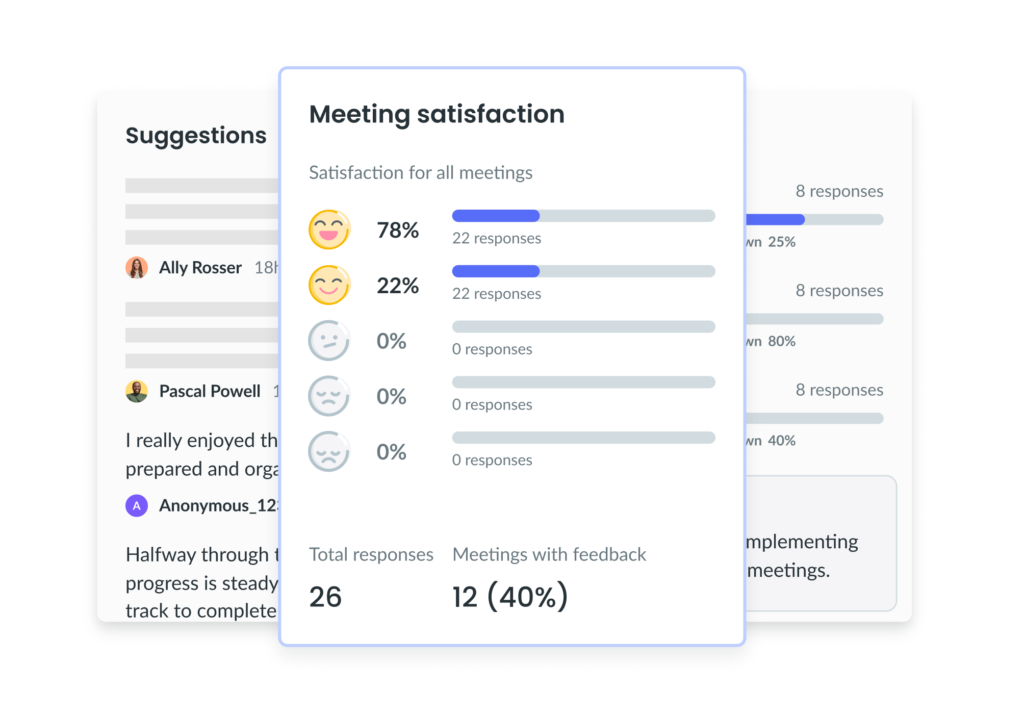
7Send a meeting follow-up email
Meeting follow-up emails are a great way to make sure everyone is on the same page after the meeting has concluded and an even better way to ensure you’ve hosted an impactful meeting. The best part about sending follow-up emails is that you’re able to loop everybody in, whether or not they were able to attend the meeting. This email is also a great opportunity to send any notes or meeting minutes to all relevant parties. If you’ve ended the meeting with action items, this is the ideal time to reiterate who’s responsible for what, and what’s expected of them.
8Shorten your meetings
Did you know that one of the easiest things that you can do to increase meeting productivity is to shorten your meetings? You may not realize it, but hosting lengthy meetings could be costing your organization thousands of dollars per year. An internal company experiment conducted at Fellow showed that scheduling meetings for shorter durations—specifically, 50 minutes instead of 60 minutes and 25 minutes instead of 30 minutes—can greatly improve meeting efficiency and attendee focus on critical priorities.
9Host asynchronous meetings
As the world continues to embrace remote first principles, asynchronous meetings are becoming increasingly popular. Meeting asynchronously simply means to meet or check in at one’s leisure as opposed to meeting in real time. Instead of expecting team members to gather and chat in real time, managers or leaders encourage team members to respond asynchronously at a time that works for them, leaving more time for uninterrupted work. This meeting format works particularly well if your teammates are dispersed across multiple time zones, have conflicting schedules, or if you wish to provide your teammates with more time to focus on deep work. Additional benefits include flexibility, increased productivity, reduced meeting overload, time for research and preparation, and reduced stress and anxiety.
10Have a meeting-free day
A meeting-free day is a day within the work week that doesn’t have any meetings and traditionally takes place one day per week. On this day, teammates block off their calendars to focus on deep work. This means no team meetings, one-on-ones, recurring meetings, or any other kind of meeting. The benefits of leveraging meeting-free days are incomparable, with one of the most notable being increased meeting productivity. Additional benefits include making time for deep work, having additional time for complex tasks, increasing the efficiency of remaining meetings, feeling a strong sense of accomplishment, finding a creative rhythm, and reducing stress. Conducting a calendar audit and determining which meetings can be nullified or merged is a great way to get started.
The best and easiest way to implement a no meeting day is by using a tool that has the functionality already baked in. As part of the Meeting Guidelines feature set, Fellow enables company leaders to set a no meeting day for their organization, so that any time someone tries to schedule a meeting on that day, they will be automatically prompted to find another time.
11Assign meeting roles
To increase meeting productivity, you must assign meeting roles. Not only will assigning meeting roles help you run an efficient meeting from start to finish, but it will also heighten engagement among meeting participants. Key roles include a host, a timekeeper, and a note-taker. The host will be responsible for everything from invites to direction during the meeting, the timekeeper will oversee timing attendees when there’s a structured agenda, and the note-taker will be in charge of keeping track of key talking points and decisions. The note-taker’s duties also include noting key takeaways and next steps so those in attendance remain accountable for their action items when the meeting finishes.
Increase meeting productivity with Fellow
Fellow drives engagement and productivity before, during, and after every meeting by fostering accountability, encouraging continuous improvement, and enabling important conversations—all through one easy-to-use tool that can be accessed through the Google Chrome or Firefox browser extensions. With these browser extensions, you can access your meeting notes right inside of Google Meet calls and your Google Calendar to supercharge team meetings and one-on-ones without leaving the tools you’re already using.
Plus, Fellow’s AI-generated meeting agendas, suggested topics, and AI meeting transcription (coming soon!) elevate your meetings from start to finish. Use AI to instantly build thoughtful meeting agendas, stay present with AI meeting transcription (coming soon!), and keep an accurate record of discussions and decisions with AI meeting summaries.
Interested in learning more about how Fellow can help you and your team members collaborate on meeting agendas, record decisions, and keep each other accountable? Book a demo today!
Are you prepared to increase meeting productivity?
Considering these tips when hosting your next meeting will ensure you increase meeting productivity from here on out. Don’t forget to check out the Fellow blog for more productivity hacks and best practices!
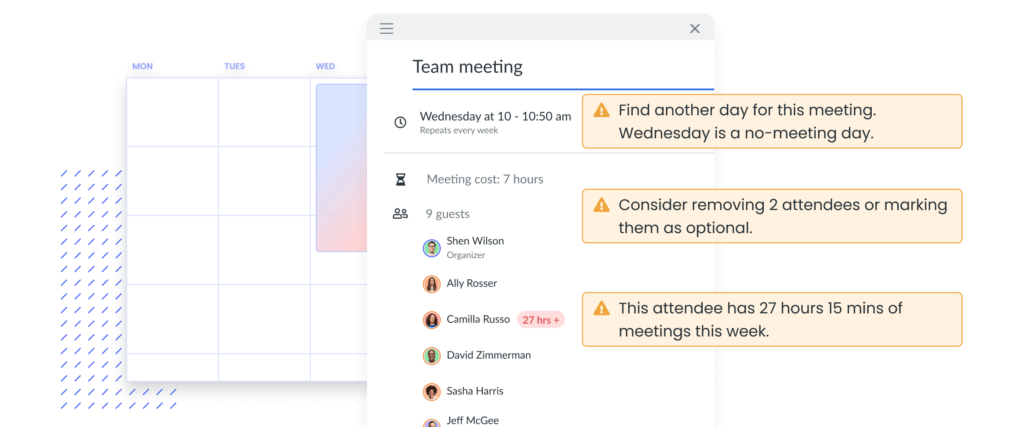
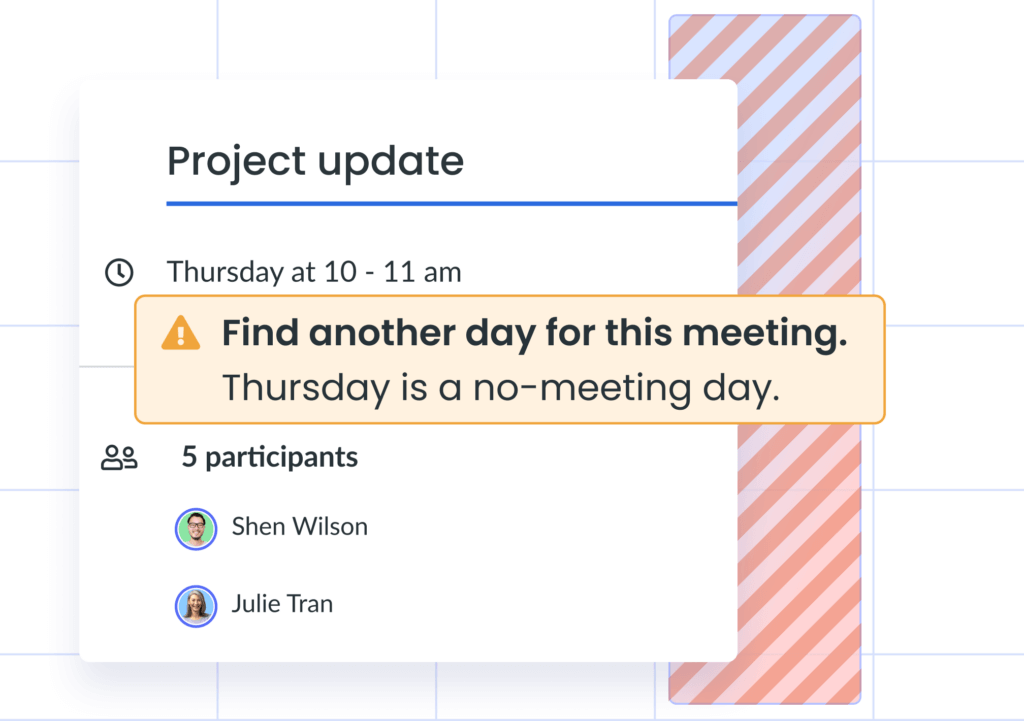
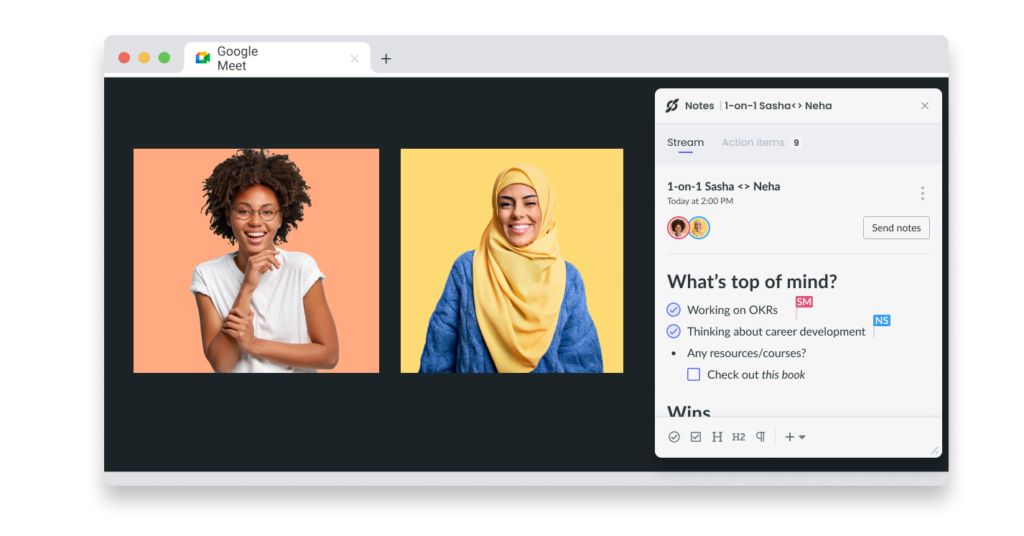









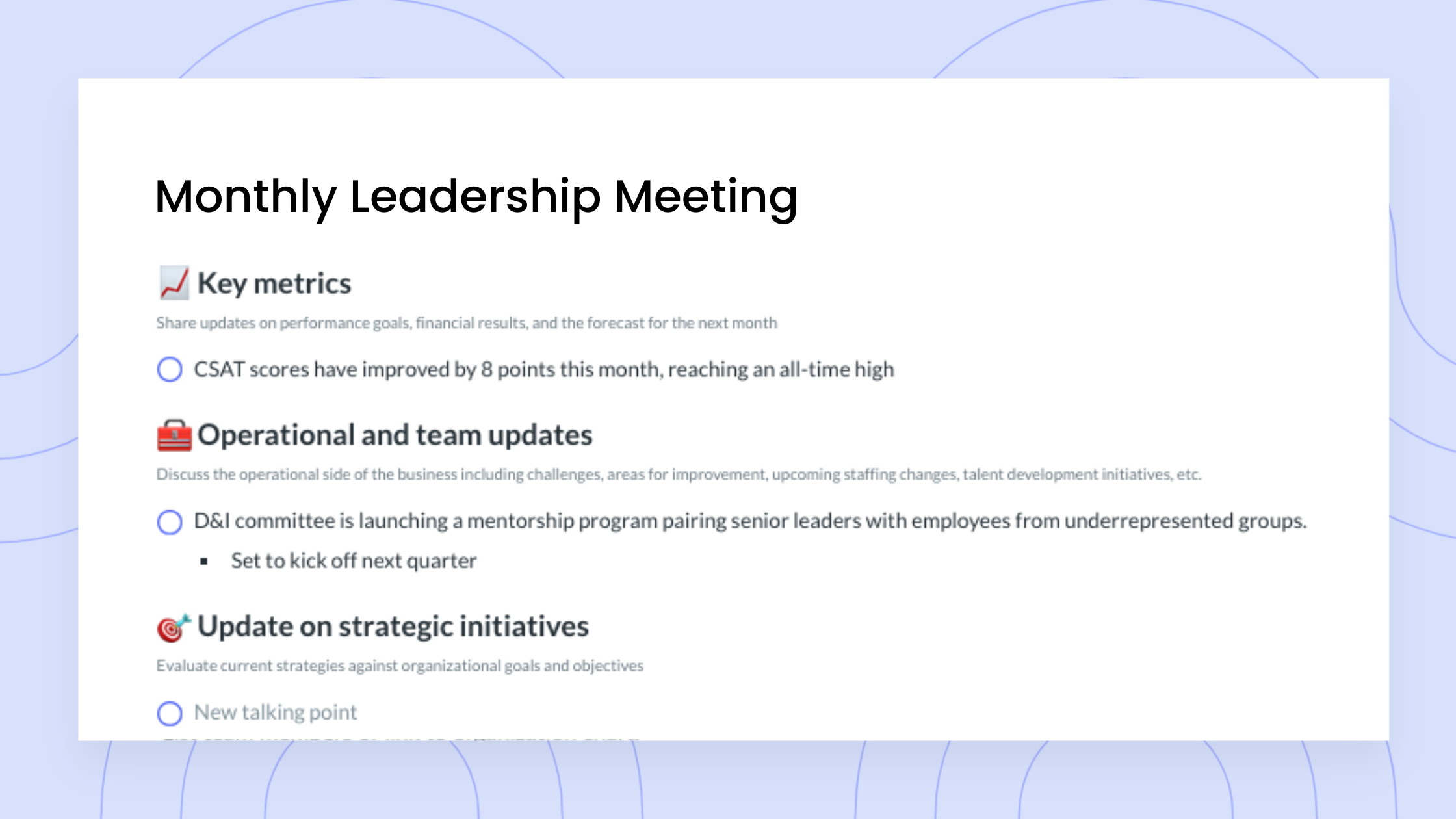

![Incoming Client Interview [Legal Clinic] Template](https://fellow.app/wp-content/uploads/2021/09/Incoming-Client-Interview-Legal-Clinic-preview.png)

